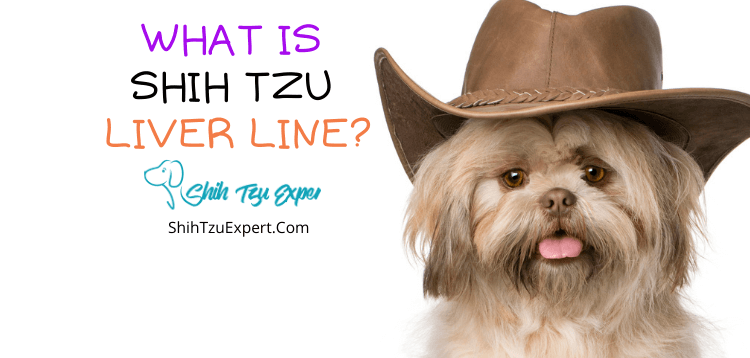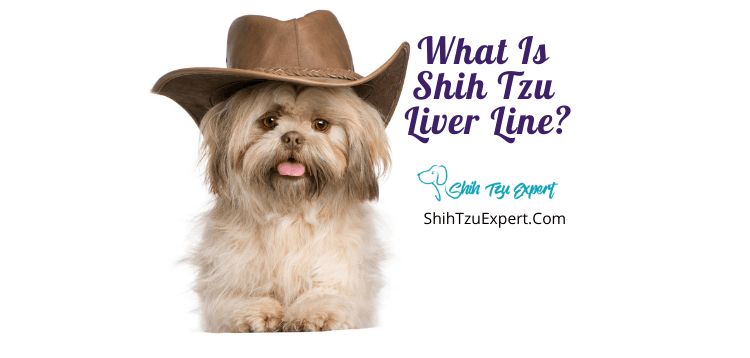Liver Line Shih Tzus are a new and a unique concept to many dog owners. This is because of the vast amount of misconceptions surrounding this breed.
Adopting a Liver Line requires planning and forethought before you begin, especially if you like to travel with your Shih Tzu!
Here are all the facts, so you know what you are in for….
What Is Shih Tzu Liver Line?
When it comes to Shih Tzu colors, dog owners can choose from a vast array of shades and patterns. There are eight colors officially recognized by the American Kennel Club, and sometimes it can be tricky to distinguish them. Today we’ll be taking a look at one of the most beautiful: the liver line, or AKC color code S 123.

The Shih Tzu liver line is characterized by its beautiful chocolate color. Colors range from a light brown, which often has a shiny pink overlay, to deep dark chocolate.
What’s essential to keep in mind about Shih Tzu coloring is that it’s based on the color of the skin, not the fur. In the case of the liver line, skin points like the eye rims, nose, lips, and paw pads determine the dog’s coloring. You’ll have to look to these areas to get the true story of your Shih Tzus’ coloring. The best place to notice the liver color is typically the nose.
Because skin pigmentation is the deciding factor, there can be significant color variation among liver line Shih Tzus. Though they are mostly brown, they are by no means exclusively brown.
So although liver Shi Tzus are mostly brown, they aren’t always exclusively brown.
Are Liver Line Shih Tzu Rare?
Liver line Shih Tzus are somewhat rare, but they’re not the rarest. That title goes to black Shih Tzus, which are quite difficult to find–especially the ones that are completely black.
Are Liver Shih Tzus More Expensive
The Shih Tzus breed is not cheap no matter what color you get, but liver line Shih Tzus do tend to be more expensive than other colors. A liver line puppy can cost you upwards of $3,500.
Shih Tzu Liver Line Characteristics
As we mentioned above, liver line Shih Tzus are not exclusively brown, so their coat can be practically any color. Sometimes they even have a light cream coloring. Additionally, liver line Shih Tzus come in solids (sometimes with markings) and double and tri-colors. They can have green or amber eyes.
However, as we’ll see below, color can change quite dramatically as the dog gets older.
How To Know If Your Shih Tzu Is Liver Line
So how can you tell if your dog is liver line? It’s simple: all you have to do is look at their nose. If it’s brown, they are liver-colored.
Shih Tzu Liver Line Black
Some Shih Tzu liver line puppies can have a solid black coat, though their nose will always differentiate them from actual black Shih Tzus, who have a black nose.
Shih Tzu Liver Line Brown
As mentioned above, the colors of the Shih Tzu liver line run the gamut of the brown spectrum. Some people refer to very dark liver colors as “chocolate,” but the American Kennel Club does not recognize chocolate as an official color.
Shih Tzu Liver Line White
The Shih Tzu Liver and white line is another possible combination for this breed. The AKC code is S 125, resulting in beautiful white and brown coloring. These colors are sometimes referred to as liver-colored areas or spots.
Shih Tzu Liver Line Snub Nose

You may have heard that Shih Tzus are snub nose dogs, which means their snout is shorter than normal. The short snout causes the dog to have a compressed nose and sinuses, and it also gives them smaller nostrils, which makes it harder for them to breathe. Other examples of popular short-nosed dogs are bulldogs, pugs, and Boston terriers.
Keep in mind that traveling with snub nose dogs is more difficult. Most airlines don’t allow them in the cargo hold because they are at increased risk on planes. If you are interested in a liver line Shih Tzu, it’s important to be aware that air travel would require extra planning and precautions.
Shih Tzu Liver Line Puppies
A word of caution for anyone searching for a specific liver line brown: don’t become attached to a particular color that you see on a young puppy. A puppy’s color typically changes so drastically that by their first birthday, they often no longer resemble the one on their AKC paperwork.
Even black-coated liver line Shih Tzus can change color as they get older, mainly because of sun exposure.
Pure Shih Tzu Liver Line
For a Shih Tzu puppy to be considered purebred, both of the dog’s parents have to be purebreds. Their grandparents and great-grandparents all must have Shih Tzu ancestry, too. So how do you know about your dog’s family history?
The easiest way to find out is by checking with the breeder. If the breeder registered the dog with the AKC or KC as a purebred, the papers will prove the dog’s ancestry. Similarly, a breeder will be able to tell you if a puppy you are considering is purebred.
Otherwise, you can compare the dog with the breed standard or arrange for a DNA test.
Fully Grown Shih Tzu Liver Line
Fully grown, Shih Tzus are 9 to 10 ½ inches tall, and they weigh anywhere from nine to sixteen pounds.
Shih Tzu Liver Line Vs. Princess Type
You may have heard the term “Princess Type” and been curious about what it meant.
Princess type is another name for Imperial or Teacup Shih Tzus. Imperials have been bred as large Shih Tzus, whereas Teacups are tiny Shih Tzus. However, the American Kennel Club does not recognize Imperials or Teacups; rather, the term is used for marketing these dogs.
What Is Shih Tzu Liver Line Princess Type & How Much Are They?
Therefore, a liver line princess type is simply an Imperial or Teacup Shih Tzu with liver line coloring.
If you see advertisements for princess types, it’s best to be wary of the breeder. These dogs tend to have genetic defects, which more often than not lead to health issues down the road. They’re not suitable for everyone, so you don’t want to get caught off guard.
![12 Best Dog Foods for Toy Breeds [Buyer's Guide] 12 Best Dog Foods for Toy Breeds [Buyer's Guide]](https://shihtzuexpert.com/wp-content/uploads/2019/05/3-5.jpg)



